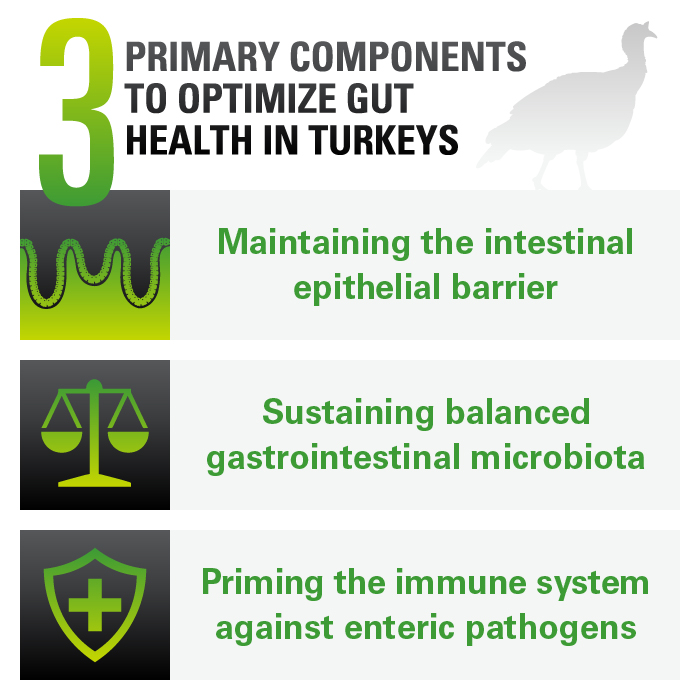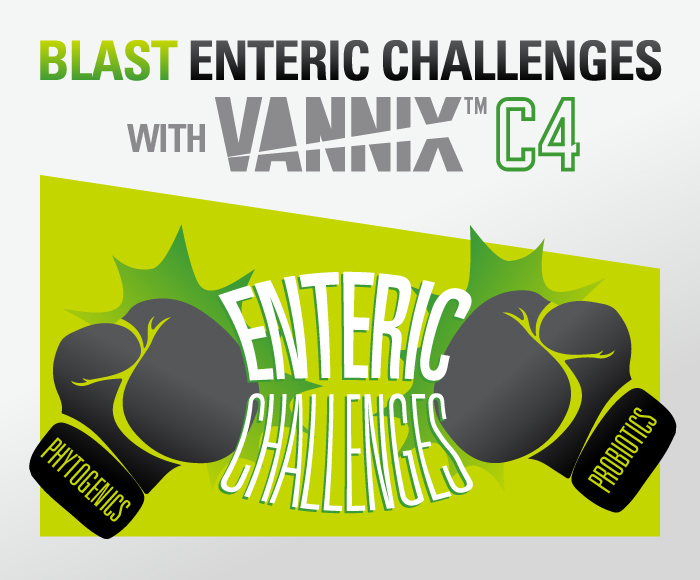Managing Coccidiosis in Different Systems
Comprehensive management of diseases like coccidiosis calls for a different strategy when producing turkeys in an antibiotic-free (ABF) system that limits or prohibits the administration of antibiotics. Turkeys normally ingest the parasites through bedding, making elimination in litter unlikely. "Coccidia are really hard to get rid of 100%. The eggs have a very thick wall, and they can survive for years in the environment," Pollock said. Further, because coccidia management tools are limited in turkey production, ABF turkey systems are faced with even greater challenges to minimizing risk of infection without a phytogenic like VANNIX C4.
"The problem with turkeys in either conventional or ABF production is that there are limited therapeutic treatment options are available. Infected poults will fail to gain weight and suffer intestinal damage, and there are even fewer tools for ABF birds. They can use a chemical coccidiostat or a vaccine, some of which can be produced for a specific farm," Pollock said. "Conventional farms can use ionophores and chemical coccidiostats — which protect birds from coccidia as well as support growth. Unfortunately, ionophore coccidiostats are considered an antibiotic and as such cannot be used in ABF birds. The problem is that in some cases, a chemical coccidiostat doesn't always provide 100% protection. That's when an alternative route like VANNIX C4 comes in handy in providing birds a boost, whether they're conventional or ABF."
Turkeys ingest coccidia parasites primarily from pecking at bedding materials. The number of oocysts, taken in contributes to the severity of infection or developed immunity. Susceptibility is highest early on in life, facilitating treatment with a vaccine or coccidiostat up until about seven to eight weeks of age is critical, Pollock said. In ABF production live or autogenous vaccination, chemical coccidiostat and/or feed additive treatment — including with a phytogenic, organic acid, or probiotic— is typically the only viable way to control intestinal damage from the disease once birds are infected; cleaning facilities is critical to knock down oocyst populations when barns are vacant, but this is difficult given oocysts are tough to kill with common disinfectants.
“Turkeys will pick up the oocysts from the feces in the bedding,” Pollock said. “Between day 0 and day 60, we want to have a coccidiostat or a vaccine. After that, they stop being susceptible. We grow turkeys for 20 weeks, so we don’t treat them for that long when we use a phytogenic. Usually, with VANNIX C4, we recommend it from day 0 to day 49 or 60.”
Potential Damage to Turkeys
Coccidiosis parasites endanger turkey gut health by penetrating and replicating in GI epithelial tissue, where one of five Eimeria — E. meleagrimitis, E. adenoids, E. caecae, E. gallopavonis and E. meleagridis — can inflict further epithelial damage in different GI tract areas. The parasites are also dangerous as pre-disposing factors for other diseases; coccidiosis can open the door to Clostridium spp. infections and may result in necrotic enteritis.
“Clostridium can reproduce, become more active and cause secondary bacterial infections. Coccidia in the animal can lead to a Clostridium infection, so you end up having two problems instead of just one. In severe cases, those clostridia can get into the bloodstream and lead to systemic internal damage,” Pollock said.
Coccidiosis has a number of symptoms relating to performance and appearance. Feed efficiency declines sharply because of the GI inflammation and lesion formation the disease causes. On the more severe end of the spectrum, the parasite can cause abrupt high mortality. It is important to note that the Eimeria that affect turkeys are different than the one that affects broilers, therefore the intestinal damage between the two species is somewhat different.
“First and foremost, the birds lose body weight, and feed conversion rates suffer. When you look at birds, you will have dull, hunched birds with ruffled feathers. You can tell they’re feeling sick,” Pollock said. “You can have sudden death, too. Diarrhea that is also watery and can contain mucous. One interesting thing here is that blood in the diarrhea is rare compared to chicken coccidiosis. There are one or two Eimeria that can cause bloody diarrhea in broilers but that’s not something seen in turkeys.”
These symptoms — especially losses in feed efficiency — add up to considerable economic losses for producers, getting a return in your investment in VANNIX C4 at the farm level by improving feed efficiency, Pollock added.
“If you look at higher feed conversion, the animal needs to eat more to produce the same amount of meat. So cost of feed is increased,” she said. “We know that the price of VANNIX C4 is competitive, and it’s easy to see the return on investment, especially if you’re talking about ABF birds where the tools are limited.


